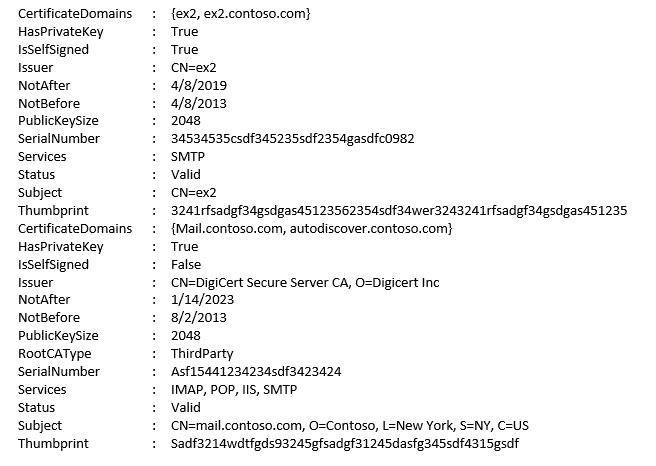What are two possible recommendations to achieve this goal?
You have an Exchange Server 2013 organization that has two sites. The sites use a single namespace.
Each site contains two Exchange servers and a hardware load balancer. Mailboxes are distributed
evenly between the sites.
Your company’s IT policy states that all users must be able to access their mailbox if one site fails.
You implement a DNS round robin solution for the Client Access server infrastructure.
When a site outage occurs, some users report experiencing intermittent slowness when they
connect to their mailbox.
You need to recommend a solution to resolve the issue.
What are two possible recommendations to achieve this goal? Each correct answer presents a
complete solution.
You need to prepare the certificate required for the planned deployment
You plan to deploy 20 Client Access servers that will have Exchange Server 2013 installed.
You need to prepare the certificate required for the planned deployment. The solution must ensure
that the same certificate can be used on all of the Client Access servers.
What should you do first?
What should you include in the plan?
You are planning an Exchange Server 2013 Deployment.
You plan to install exchange servers in two sites, SiteA and SiteB. You plan to add all exchange
servers to a single database availability group (DAG) and have all of the databases replicated to all
servers.
You implement the load balancers as configured in the following table:
You need to plan a solution that automatically allows all users to connect to their mailbox if all of the
exchange servers in one site fail.
What should you include in the plan?
Which command should you run?
You have an Exchange Server 2013 organization that contains one office in Los Angeles and one
office in New York.
All servers have the Mailbox server role and the Client Access server role installed and are members
of a data availability group (DAG) named DAG1. The servers and databases are shown in the exhibit.
(Click the Exhibit button.)
You need to ensure that if the active copy of NYDB01 fails, a server in the same site will attempt to
activate a copy of the database before a server in another site does. The solution must not influence
the activation of other database copies.
Which command should you run?
What should you modify?
You have an Exchange Server organization that contains Exchange Server 2010 servers and Exchange
Server 2013 servers. You have a Microsoft Lync Server 2010 environment that is integrated with
Unified Messaging (UM) services.
You have an Exchange Server 2010 server named EX1 that has the Unified Messaging server role
installed.
You are migrating the UM services to Exchange Server 2013.
You need to prevent EX1 from providing call answering services during the migration.
What should you modify?
Select the correct option of below answer area now.
HOTSPOT
You company has two offices. The offices are located in Los Angeles and New York.
You manage an Exchange Server 2013 organization.
A database availability group (DAG) named DAG1 contains servers from the Los Angeles office and
servers from the New York office. There are copies of all the databases on all of the servers. The New
York office is the primary data center and hosts all of the active database copies. As well as the
witness server.
You run the Get-DatabaseAvailabilityGroup command and you receive the following output.
Select the correct option of below answer area now.
Use the drop-down area to select the appropriate answers.
Use the drop-down menus to select the answer choice that completes each statement.
HOTSPOT
You manage an Exchange Server 2013 organization that has an organization relationship with a
partner company named Contoso, LTD.
Contoso has an Exchange Server 2013 organization and has Microsoft Outlook 2013 deployed to all
users.
You run the Get-OrganizationRelationship | fl and you receive the following output.
Use the drop-down menus to select the answer choice that completes each statement.
Which type of virtual hard disk should you create on the LUN?
You have a server named Server1 that runs Windows Server 2012 R2. Server1 has the Hyper-V server
role installed.
An iSCSI SAN is available on the network.
Server1 hosts four virtual machines named VM1, VM2, VM3, and VM4.
You create a LUN on the SAN to host the virtual hard drive files for the virtual machines.
You need to create a 3-TB virtual hard disk for VM1 on the LUN. The solution must prevent VM1
from being paused if the LUN runs out of disk space.
Which type of virtual hard disk should you create on the LUN?
Which type of virtual hard disk should you create on the LUN?
You have a server named Server1 that runs Windows Server 2012 R2. Server1 has the Hyper-V server
role installed.
An iSCSI SAN is available on the network.
Server1 hosts four virtual machines named VM1, VM2, VM3, and VM4.
You create a LUN on the SAN to host the virtual hard drive files for the virtual machines.
You need to create a 3-TB virtual hard disk for VM1 on the LUN. The solution must prevent VM1
from being paused if the LUN runs out of disk space.
Which type of virtual hard disk should you create on the LUN?









